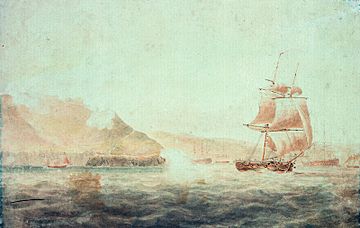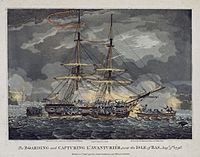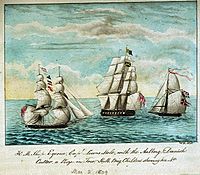HMS Childers (1778) facts for kids

French batteries firing at Childers off Brest (1793); National Maritime Museum
|
|
Quick facts for kids History |
|
|---|---|
| Name | HMS Childers |
| Ordered | 30 September 1777 |
| Builder | James Mentone & Son, Limehouse |
| Laid down | 3 April 1778 |
| Launched | 7 September 1778 |
| Honours and awards |
Naval General Service Medal with clasp "Childers 14 March 1808" |
| Fate | Taken to pieces in February 1811 |
| General characteristics | |
| Class and type | Childers-class brig-sloop |
| Tons burthen | 20615⁄94 (bm) |
| Length |
|
| Beam | 25 ft 3 in (7.7 m) |
| Depth of hold | 10 ft 11+3⁄4 in (3.3 m) |
| Propulsion | Sails |
| Sail plan | Two masted brig-rigged |
| Complement | 80 |
| Armament |
|
HMS Childers was a special kind of brig-sloop built for the British Royal Navy. She was the very first brig-sloop made for the Navy! She started with 10 guns, which later increased to 14.
Childers was ordered during the early years of the American War of Independence. She helped out in the English Channel and the Caribbean Sea. After the war, she was put away for a while. But she came back into action just before the French Revolutionary Wars began.
She had a very busy career during both the French Revolutionary and Napoleonic Wars. Childers captured many French privateer ships. A privateer was a private ship allowed by a government to attack enemy ships. She also took part in a famous battle during the Gunboat War. The Navy stopped using her in 1811, and she was taken apart.
Contents
James Mentone built Childers in Limehouse, England. He was known for building fast ships. Childers was one of only two ships he built for the Navy.
Her design was a bit unusual for a warship at the time. It was based on a fast merchant ship design, not the usual Navy sloops. This made her quick and agile.
Childers was launched in September 1778. She officially joined the Navy in October under Commander William Peacock.
After a big victory called the Battle of Cape St. Vincent, Childers carried important messages back to Britain.
French Revolutionary War Adventures
In January 1791, Commander Robert Barlow took command of Childers. Her job was to stop smuggling.
In 1793, Childers was involved in the first fight between Britain and Revolutionary France. This event became known as the Childers Incident. On January 2, 1793, she was sailing near Brest when forts there fired at her. One cannonball hit her, but luckily, no one was hurt. France declared war on Britain about a month later.
Childers captured a French privateer ship called Patriote on February 15. A month later, on March 14, she destroyed another French privateer named Triton.
In June 1793, Commander Joshua Mullock became her captain. Commander Robert Warburton took over in March 1794.
Capturing Enemy Ships
In March 1795, Commander Richard Dacres became the new captain. Childers and other British ships captured a ship called Latitia on July 6. In August, Childers sailed with a group of ships to Quiberon Bay.
On September 8, 1795, Childers joined Admiral Sir William Sidney Smith's ship, Diamond. On the way, Childers captured a French Coast Guard ship called Vigilant on September 3. The day before, Diamond had destroyed a French warship named Assemblee Nationale. Childers shared in the prize money from this capture.
Commander Dacres was promoted on October 31. In December, Commander Stephen Poyntz took command of Childers.
On April 10, 1796, Childers and other ships captured Smuka Piga. Later, on April 29, Childers shared in the prize money when another ship, Acquilon, captured Mary.
On September 16, Childers captured the French privateer Bon Esperence. This privateer had just captured a British ship called Mary Ann. Childers quickly recaptured Mary Ann and sent both ships to Portsmouth. On September 28, Childers captured another ship, Anna Louisa.
The Battle with Etna
On November 13, 1796, two British ships, Melampus and Minerva, chased a French warship ashore near Barfleur. The next morning, Melampus and Childers chased another French warship, Etna, as she left Le Havre.
Melampus started firing at Etna around 3:30 PM. Etna fought back for two hours. When Childers joined the fight, Etna finally gave up. Etna had 18 guns and a crew of 137 men. Both Etna and the ship that ran ashore were new and on their first trip. The Royal Navy took Etna into service as HMS Cormorant. The crews of Melampus and Childers received prize money for this capture.
Commander James O'Brien became captain of Childers in January 1797. On May 11, Childers and other ships captured a French privateer called Nouvelle Eugénie. She had 16 guns and 120 men.
On October 28, Childers brought the French privateer schooner Furet into Portsmouth. Childers and another ship, Triton, had captured Furet four days earlier. Furet was very fast but had only captured one ship before being caught.
On January 11, 1798, Childers and two other ships captured the French privateer schooner Vengeur. She was new and had not captured any ships yet.
Between October 1797 and May 1798, Childers captured another privateer, Tartare. She also captured a merchant ship, Twee Gysberts, and recaptured two others, Racehorse and Helen.

A Daring Night Attack
On August 4, 1798, boats from Melpomene and Childers carried out a very brave mission. They attacked the French warship Aventurier while she was anchored in the port of Corréjou. The attack happened at night and in bad weather.
The British sailors had to fight their way onto Aventurier. One British sailor was killed, and four were wounded. The French had 16 wounded. It took two hours to get Aventurier out of the port because of the bad weather and fire from the forts. It was a very daring and difficult operation. Aventurier was brought into British service as HMS Aventurier.
In March 1799, Commander James Coutts Crawford took command of Childers. On May 4, Childers helped warn the British fleet in Cadiz that the French and Spanish fleets had sailed.
Childers returned to Plymouth. On October 8, she escorted a large supply ship from Plymouth.
On March 25, 1800, a British warship named Agamemnon hit a rock and was taking on a lot of water. Childers met her and helped escort her safely into port. The next day, Childers recaptured a ship called Lady Nelson that a French privateer had taken.
On April 26, Diamond and Childers captured the French ship St Charles. A few days later, Childers helped recapture two more ships, Adventure and Amy.
On October 24, Childers captured the Spanish privateer Diligenté. She had two guns and 30 men. She had not captured any ships yet.
Childers arrived in Portsmouth in February 1801. She had escorted 12 merchant ships from Lisbon.
On September 11, Childers captured the French ship Sally. She shared the prize money with two other British warships.
Commander Crawford was promoted in April 1802. Commander John Delafons briefly replaced him, and Childers was taken out of service in November.
Napoleonic Wars Service
In August 1803, Commander Sir William Bolton recommissioned Childers for duty in the Mediterranean Sea. She sailed from Plymouth in September to join a group of ships heading to the Mediterranean.
Childers and other ships shared in the capture of the St. Gieuseppe e L'Allanza on January 14, 1804. On August 24, Phoebe and Childers captured the Venscab.
In August 1805, Commander John Lake took command. Admiral Lord Nelson noted that Childers needed repairs and should return home.
Still, on December 24, she stopped a ship called Terpsichore that was carrying sugar and coffee.
Commander Thomas Innes replaced Lake in March 1806. Innes and Childers captured two Danish ships, Johanna Seegmond and Else Christiana, on October 26, 1807.
In early 1808, Commander William Henry Dillon became the captain of Childers.
A Fierce Battle with Lougen
In March 1808, Childers was sailing off the coast of Norway. Commander Dillon saw a ship and chased it into a small port. The local people tried to take the ship's cargo, but Childers' boats arrived to capture it. They took the ship, a galiot (a type of small ship), with its cargo of oil and fish. They did this even while people on shore were shooting at them and throwing rocks.
As they returned with the captured ship, a large Danish warship, the Lougen, sailed out to try and get the prize back. A battle began that lasted about three hours. The Danish ship was much bigger, with 18 guns and 160 men. Childers had 16 guns and only about 65 men.
The ships exchanged cannon fire. At one point, the Danish ship caught fire. Commander Dillon managed to lure the Lougen further out to sea. Around 11 PM, Childers fired a close-range broadside (all guns on one side). The Lougen then broke off the fight and headed back to Norway.
Childers had holes from the cannon fire and five feet of water in her hold. Her crew had to pump water constantly. Commander Dillon could not chase the Lougen and returned to Leith with the captured galiot.
In this battle, Childers lost two men killed and nine wounded, including Commander Dillon, who was badly hurt in both legs. Dillon was promoted for his brave actions. He also received a special sword. In 1847, a medal was given to the four surviving sailors from this battle.
Commander Joseph Packwood replaced the wounded Dillon. Childers continued to capture enemy ships. On October 19, she recaptured a British ship called Lord Nelson that a Danish privateer had taken. Packwood then chased and captured the privateer, named Frernskernstern.
Childers captured many more Danish ships in 1809, including Hoop, Nordscandia, Amelia, Den For Agetede Hensight, Flundrun, and Aurora. She also shared in the capture of other ships.
In 1810, Childers captured the Prussian ship Anna Maria. She also captured several fishing boats: Zeemeuw, Mercure, Johanna, Christine, and Pappenburg. Her last capture was Neptunus on October 31.
Between December 1810 and January 1811, the crew of Childers gave a special sword to their master, George Wilson. He had bravely jumped into the sea to rescue a sailor who had fallen and was drowning.
End of Service
Childers was finally taken out of service in January 1811. She was then taken apart in February of that year. Commander Packwood was promoted shortly after.


